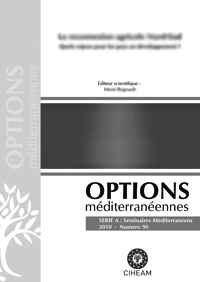| Article précédent | p. 169-173 | Article suivant |
Nitrogen efficiency component analysis in wheat under rainfed Mediterranean conditions: Effects of crop rotation and nitrogen fertilization
The research was carried out in 1999-01 in a typical Sicilian semi-arid area to evaluate the effect of crop rotation and N fertilization on the nitrogen use efficiency (NUE) in wheat. Crop rotations were: wheat-faba bean, wheat-chickpea, wheat-pea and continuous wheat; nitrogen fertilizer rates were: 0, 40, 80 and 120 kg N per ha. A split-plot design with three replications was used. Analysis of nitrogen efficiency components was performed according to the procedure of Huggins and Pan (1993) using grain yield, aboveground plant N, grain N and post-harvest inorganic soil N. Continuous wheat (WW) recorded the lowest grain yields while no differences were found in wheat grown after the three legume crops (LW); the yield benefits of LW vs WW declined as fertilizer rates increased. The differences in wheat grain yields were due mainly to N supply component at low N fertilization rates and to NUE at high N rates.
- [ Afficher ]
- [ Télécharger ]
- [ Exporter la citation ]
Vous pouvez télécharger la citation au format :
- [ Imprimer ]
-
Mots-clés
AZOTE, BLE, FERTILISATION, ROTATION CULTURALECiter cet article
Giambalvo D., Stringi L., Durante G., Amato G., Frenda A.S. Nitrogen efficiency component analysis in wheat under rainfed Mediterranean conditions: Effects of crop rotation and nitrogen fertilization. In : Cantero-Martínez C. (ed.), Gabiña D. (ed.). Mediterranean rainfed agriculture: Strategies for sustainability . Zaragoza : CIHEAM, 2004. p. 169-173. (Options Méditerranéennes : Série A. Séminaires Méditerranéens; n. 60). Final Seminar of the Regional Action Programme on Rainfed Agriculture (RAP-RAG), 2003/06/02-03, Zaragoza (Spain). http://om.ciheam.org/om/pdf/a60/04600059.pdf



